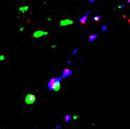Home > Research
Since 1987, the focus of our laboratory is the molecular organization of glutamatergic and GABAergic synapses in the cerebral cortex, the brain region where functions that represent the basis of human culture are generated. We are interested in the localization and regulation of molecules that participate in glutamate- and GABA-mediated synaptic transmission (presynaptic proteins, receptors, transporters) as well as in their possibile role in human neuropsychiatric diseases. In the last 10 years or so, much emphasis has been dedicated to plasma membrane and vesicular transporters.Glutamate transporters (plasma membrane)
 |
Glutamate transporters play a crucial role at glutamatergic synapses, as they regulate glutamate levels at the cleft and shape postsynaptic currents. Using traditional morphological methods, we have studied the cellular localization of glutamate transporters EAAC1 and GLT-1; currently, using more sophisticated techniques we are now trying to provide a more elaborated picture of their cellular and subcellular localization and to understand their functional impact in cortical microcircuits. |
 |
We are studying glutamate transporters, namely GLT-1 (EAAT2), also from a different perspective: their possible role in the dysregulation of synaptic function, and thereby in information processing, occurring in several neuropsychiatric disease (e.g., schizophrenia, migraine etc.). To this end, using an array of different techniques, we are studying the expression and function of GLT-1 in the cerebral cortex of animal models of diseases and/or in tissue from patients. |
GABA transporters
 |
GABA transporters contribute to determining GABA levels in the synaptic cleft and extracellular space. We have investigated the cellular and subcellular localization of the three GABA transporters that are expressed in the cerebral cortex, GAT-1, GAT-2 and GAT-3, and their role in pathophysiology. Currently, we are using transgenic mice to reveal their role in tonic and phasic GABAAR-mediated inhibition. |
Glutamine transporters
 |
The “glutamate-glutamine” cycle plays an important role in recycling of glutamate between neurons and astrocytes and in replenishing glutamate and GABA neurotransmitter pools. Whereas glutamine efflux from astrocytes is mediated by SNAT3, its influx into neurons is not clearly defined. We are trying to identify the mechanisms by which neurons maintain their glutamine supply, mostly by studying the expression and localization of the system A transporters SNAT1 and SNAT2. |
Glutamate and GABA vesicular transporters
 |
Glutamate and GABA are accumulated in synaptic vesicles by specific vesicular transporters, VGLUT1-3 and VGAT respectively, which are fundamental players at glutamatergic and GABAergic synapses. We are studying their developmental profile localization, regulation and functional role in the cerebral cortex. We are also exploiting the selective expression of VGLUTs and VGAT to examine the heterogeneous expression of presynaptic proteins in glutamatergic and GABAergic axon terminals. |
The aging synapse
 |
Recently, we have started a new research program in collaboration with INRCA IRCCS to unveil the molecular mechanisms responsible for reduced synaptic plasticity in physiological brain aging. We are tackling this problem by differentiating aged rats on the basis of their cognitive performance and electrophysiological features before studying the expression of synaptic proteins (synaptome). We are also interested in verifying whether these alterations occur in pathological brain aging. |
